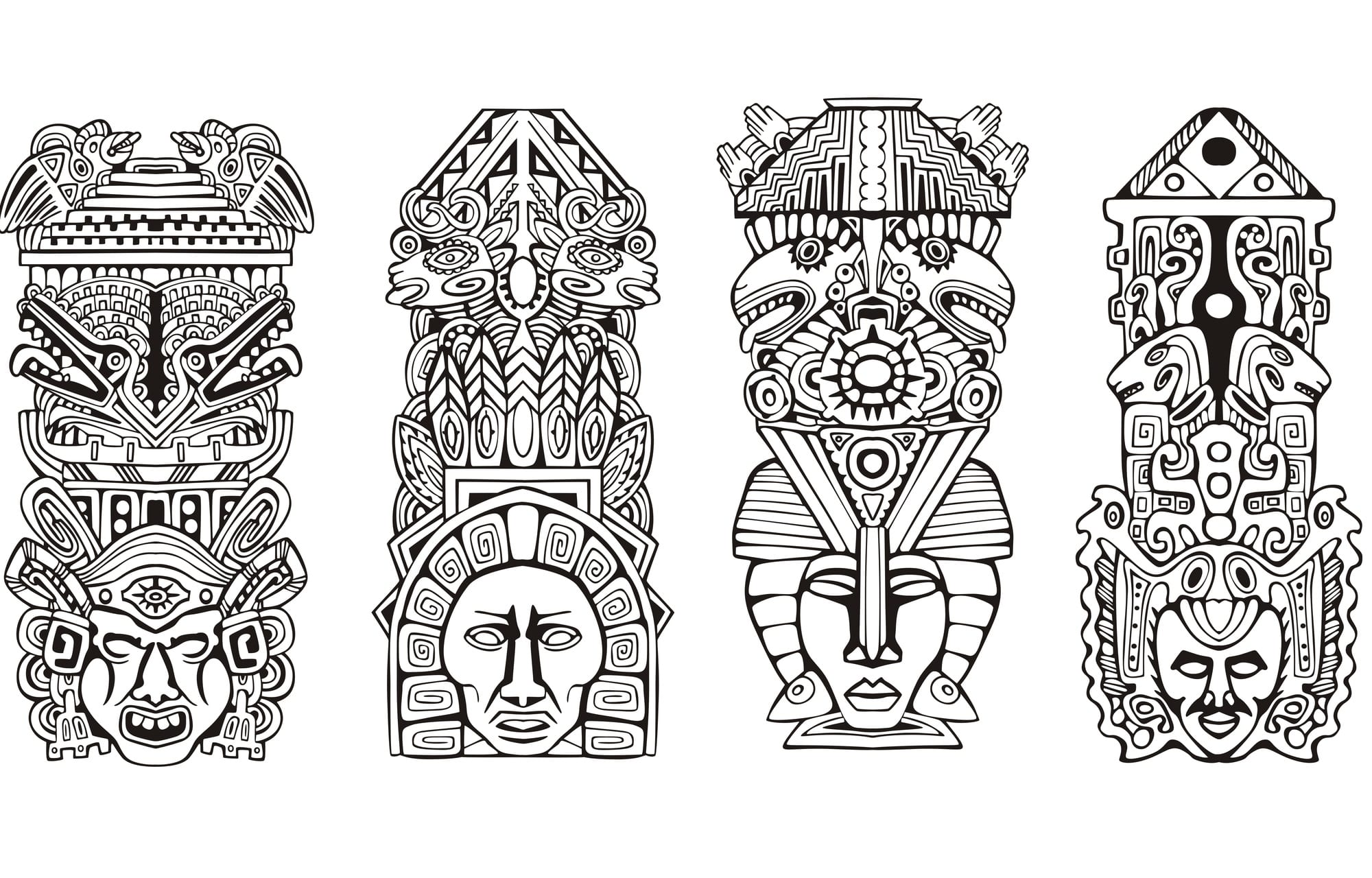The Aztecs are one of the Indigenous Peoples of the Americas who lived in the 14th to the 16th centuries. They ruled a large area in what is today central and southern Mexico.
The Aztec Empire was a powerful empire in Mesoamerica until the 16th century. But the Spanish explorer Christopher Columbus‘ landing in the Caribbean changed everything. The Spanish invaders who came after him took the last Aztec king prisoner and destroyed the empire.
The Origin of the Aztec civilization
Don’t want to read this long story? Skip this section and read the jist of the story.
It is unclear where the Aztecs exactly came from. But the Aztec people have a legend that explains their origin. This legend is explained in Crónica Mexicayotl, a chronicle of the history of the Aztec empire, written in the 16th century.
Nomads from the north
According to this legend, the Aztecs were initially a nomadic tribe of hunter-gatherers who survived mostly by fishing. They lived in their mythical homeland of Aztlan, in Northern Mexico. Hence, they came to be known as Aztec, which is derived from Aztecah, meaning ‘the people from Aztlan.’
Migrating south
In the 13th century, through the mouth of an Aztec priest, their war and sun god Huitzilopochtli spoke to them. He told them that their real home was actually in the south and that he would lead them to it. So, these people packed up their belongings and started their great migration along with the other tribes in the area.
Even though the travel was not an easy one, Huitzilopochtli motivated them through words of encouragement and showed them the way through signs. After they had traveled a long way, he also asked them to split from the other tribes and change their name to Mexica. Thus, the Aztecs became Mexica, the name by which the Spanish invaders would come to know them centuries later.
But by the time the Mexica reached Mesoamerica, there were already two established city-states in the region – Culhuacan and Azcapotzalco.
Mexica and Culhuacan
The Mexica were somehow able to convince one of these powerful city-states, Culhuacan, to let them settle in their land. By letting them settle, the chieftain of Culhuacan hoped to assimilate them into his culture and use them as soldiers. So, the Mexica joined Culhuacan, and their warriors started serving as the mercenaries of Culhuacan.
But soon, the Mexica were enchanted by the chieftain’s daughter. So, they wanted to make her their goddess and killed her in the process. When the Culhuacan found out what the Mexica had done to their princess, they started a war against the Mexica. The Mexica somehow managed to flee from the Culhuacan army and stayed hidden in the islands in Lake Tecoco.
Then, one day, Mexica’s leader had a dream. In this dream, their god Huitzilopochtli told them to settle in the place where they find an eagle pecking at a cactus fruit. So, the Aztecs started searching for this sign.
They finally found an eagle perched on a cactus on the marshy land near Lake Texcoco. So, considering it their god’s will, they started working on establishing their kingdom there. They drained the marshy land, built artificial islands to plant gardens, and laid the foundation for what would later become their capital city, Tenochtitlán, where Mexico City is today.
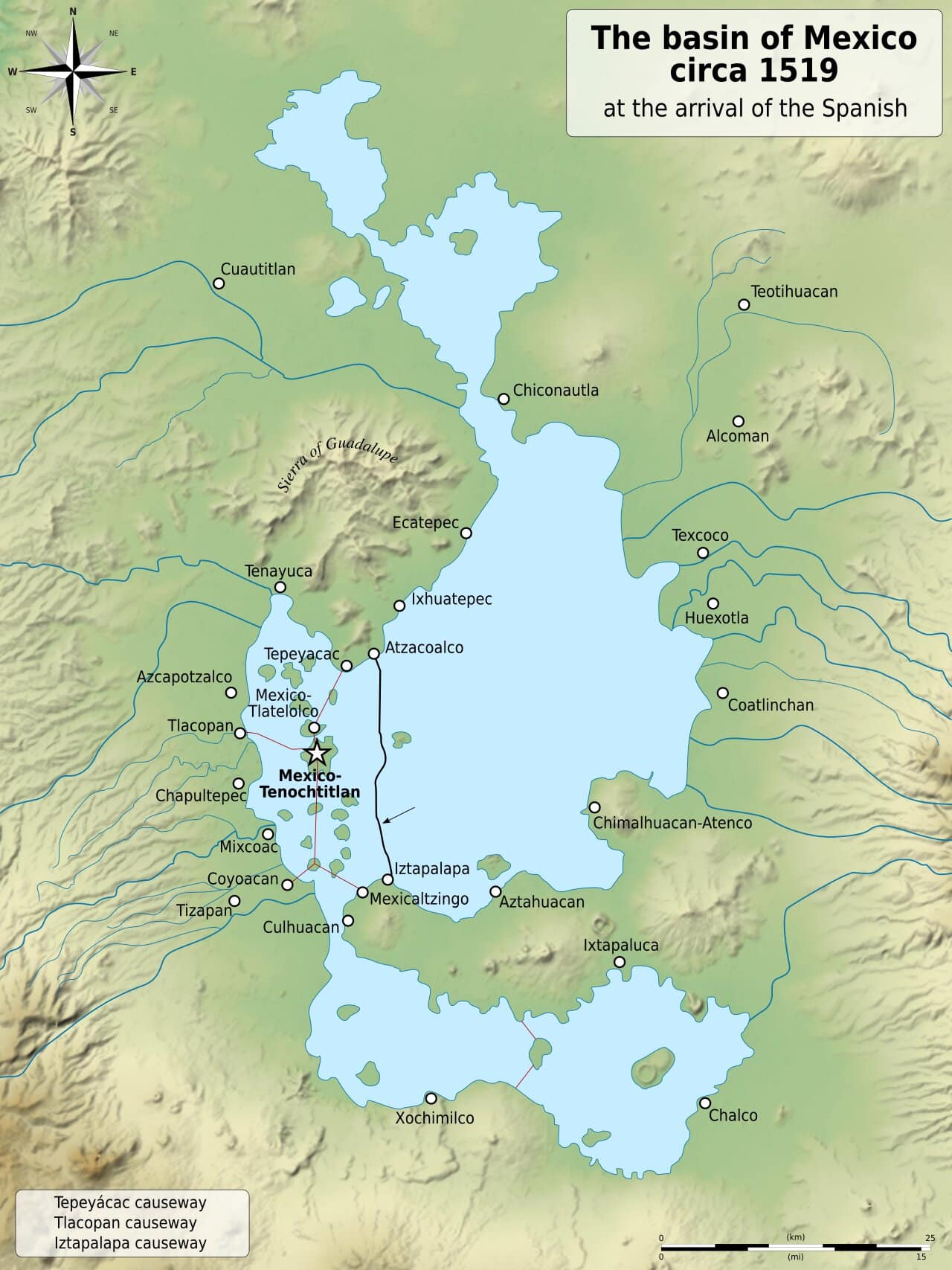
The Location of Tenochtitlan – By File:Lago de Texcoco-posclásico.png: YavidaxiuFile:Valley of Mexico c.1519-fr.svg: historicair derivative work: Sémhur – File:Lago de Texcoco-posclásico.png, itself from :(fr) Niederberger Betton, Christine (1987) Paléo-paysages et archéologie pré-urbaine du Bassin de Mexico, Mexico: Centro de estudios mexicanos y centroamericanos (CEMCA), pp. 500 ISBN: 3785726.File:Valley of Mexico c.1519-fr.svg, itself from :(en) Coe, Michael; Snow, Dean; Benson, Elizabeth (1986) Atlas of Ancient America, Category:New York: Facts On File, pp. 240 ISBN: 978-0816011995.(en) Townsend, Richard F. (1992) The Aztecs, London: Thames & Hudson, pp. 224 ISBN: 978-0500021132.(es) This picture incorporates information from La cuenca de México, special edition of Arqueología Mexicana, july-august 2007, Mexico (in particular, the Enrique Vela’s maps of the pages 70 and 60, based on Sanders et al. The Basin of Mexico, 1979).(es) This picture incorporates information from this version of Lago de Texcoco on the Spanish Wikipedia., CC BY-SA 4.0, Link
Mexica and Azcapotzalco
Thus, in 1325 AD, the Mexica settled in Mesoamerica. But they were initially not powerful. So, they continued to serve as mercenaries of war for other city-states. In 1376 AD, they formed their first royal dynasty.
Then, due to their lack of power, they became a tributary of Azcapotzalco, the other powerful city-state in that area. They served under Azcapotzalco for the next 50 years until the ruler of Azcapotzalco died.
In 1426 AD, the ruler of Azcapotzalco died. So, his sons started fighting among themselves over Azcapotzalco’s throne. During this process, Mexica’s ruler, who was also considered a competitor to the throne, was killed. So, annoyed, the Mexica decided to take revenge on Azcapotzalco.
But Itzcoatl, the man who became Mexica’s king after his nephew (the previous king of the Mexica) was murdered, knew it wouldn’t be an easy task. So, he decided to form an alliance with other city-states. Not just any city-states, but the ones who were wronged by Azcapotzalco and had little chance of rising to power on their own. He chose two city-states that suited this criteria – Tlacopan and Texcoco – and then formed an alliance with them.
Together, they besieged Azcapotzalco. Then they captured the city in 1428 and killed its princes.
The Aztec Empire
This alliance between the three city-states – Tenochtitlán (Mexica’s city-state), Tlacopan, and Texcoco came to be known as the Aztec Empire. After winning the war against Azcapotzalco, these three city-states started expanding their territories rapidly. The loot and the tribute they obtained were divided among the three city-states, and the rulers of each of these city-states took turns in ruling the Aztec Empire.
Due to their cooperation, the Aztec Empire became a powerful force in the Valley of Mexico. Among the three city-states, Tenochtitlán became the most dominant.
One of the people who played a major role in Tenochtitlán’s domination was Itzcoatl’s nephew Montezuma I. So, he became the Mexica Emperor after Itzcoatl died in 1440. Montezuma I was a great warrior. He took the Mexicas to even greater heights and came to be known as the father of the Aztec Empire.
Expansion
The Aztec Empire used different methods to conquer other smaller city-states.
If a city-state agreed to pay tribute, the Aztec Empire allowed it to remain in power unmolested.
But if it resisted, the Aztec Empire conquered it and installed a friendly ruler to rule that city-state.
Some city-states which resisted strongly or killed the Aztec Empire’s emissaries were destroyed, and their people were completely decimated, which was the case with the Huastec people. Their city was completely destroyed, and their men, women, and children were killed without mercy for opposing the Aztec Empire. The Aztec Empire completely erased all traces of the existence of the Huastec people from the face of the earth.
Thus, by using various methods, the Aztec Empire expanded rapidly.
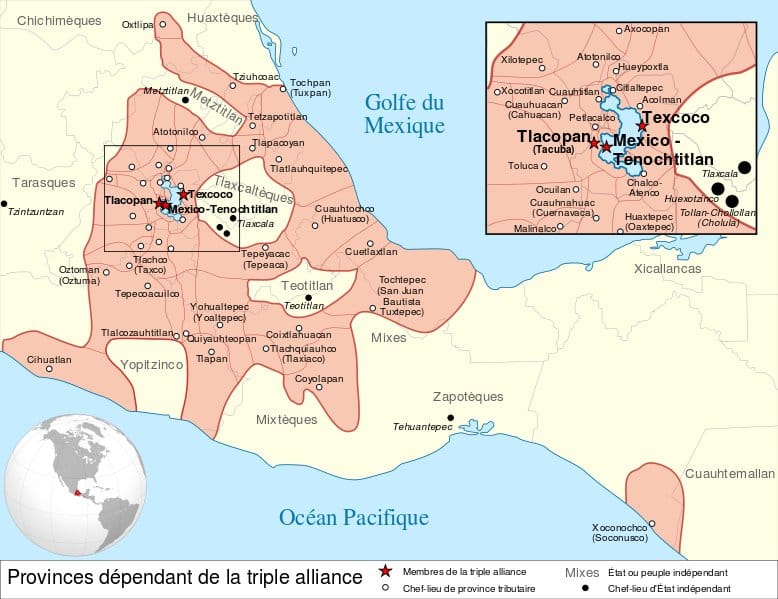
Map of the Aztec Empire in the 16th century (Picture credits)
At the peak of its existence, in the 16th century, the Aztec Empire ruled over some 500 small city-states. Almost five to six million people lived under its banner. Tenochtitlán alone housed 140,000 people and became the most densely populated city in Mesoamerica. It was a bustling city with thousands of people coming into and going out of the city every day. Its markets, which were visited by almost 50,000 people on important market days, made it a wealthy city.
Jist of the story
- According to their legend, the Aztecs were people who lived in the mythical city of Aztlan in northern Mexico.
- They started moving south when their god told them that their original home was in the south and he would lead them to it. He also told them to change their name to Mexica.
- He told them that a sign – an eagle perched on a cactus plant – would show them where they should settle.
- The Mexica searched far and wide for this sign.
- Finally, they found this sign near Lake Texcoco in 1325 AD. So, they established their capital city there, which came to be known as Tenochtitlán (located in Mexico City).
- For the next 50 years, they served as mercenaries of war for other city-states.
- Then, they became a tributary of another powerful city-state, Azcapotzalco, in 1376 AD.
- In 1426 AD, (most probably) Azcapotzalco’s prince killed Mexica’s ruler.
- So, to exact revenge for their ruler, Tenochtitlán (Mexica’s capital city) formed an alliance with two small city-states – Tlacopan and Texcoco. Together, they sieged the city of Azcapotzalco and destroyed it in 1428 AD.
- This triple alliance of Texcoco, Tlacopan, and Tenochtitlán came to be known as the Aztec Empire.
- After its victory, the Aztec Empire expanded rapidly. Within a hundred years, it became a dominant force in the Valley of Mexico, controlling over 500 city-states and ruling over five to six million people.
Aztec culture
Social structure
The Aztecs had a strict social hierarchy to classify their people.
At the top of this hierarchy was the king of the Aztec Empire and his family.
Below the king and his family were the rulers of individual city-states. They lived in big palaces in their own cities. They had complete power over their individual cities as long as they kept paying tribute to the Aztec emperor.
Below the rulers of individual city-states were the nobles. High-level priests, government and military leaders, and lords were part of this class of Aztecs. Nobility was passed down the family. Priests had their own hierarchy and were expected to abstain from sex and alcohol. If not, they were punished severely.
Below the nobles were the commoners. Merchants, artisans, low-level priests, and farmers were considered commoners. Merchants and artisans were the richest people among commoners and enjoyed better benefits. Wealthy merchants who traveled long distances to bring luxury goods were treated not as commoners but as nobles because their services were important for the Aztec economy.
Serfs (slaves) were at the bottom of the Aztec social hierarchy. Prisoners of war, people who committed crimes, and those who failed to pay tribute became slaves. An Aztec could also sell himself or his children into slavery. Slaves could marry, have children, or substitute another Aztec in their place. They could become free by buying their own freedom or by marrying their owner. They became free also when their owners died. Slavery wasn’t hereditary and wasn’t passed down to children.
In Aztec society, women couldn’t hold high administrative positions.
Religion
Thus, the Aztecs were divided into different classes based on the family they were born into. But even though the social hierarchy split them into different classes, there was one thing that united them – religion. After all, the Aztecs were highly religious people who worshiped many gods.
And to honor their gods, they built towering pyramids and magnificent temples. Their devotion to their gods even motivated them to kill other people in the name of sacrifice.
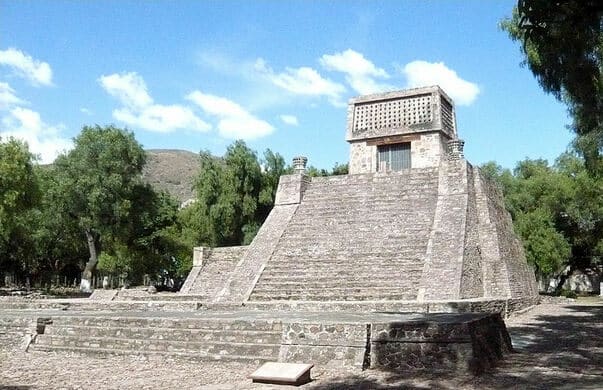
A partially reconstructed Aztec Pyramid in Tlalnepantla (Picture credits)
Human Sacrifice
Just like the Maya, the Aztecs, too, sacrificed humans to their gods. But their reason for doing so was different.
The Aztecs believed that they were created from the blood of their gods. Moreover, their god of war and god of sun, Huitzilopochtli, was constantly waging war against evil darkness. If evil darkness ever won, the world would be destroyed. So, to repay their debt to the gods, as well as to save themselves and to keep the sun rising and setting every day, they had to nourish their gods. And offering human blood was the best way to do that.
Therefore, they brought humans to the altars atop huge pyramids. There, they cut the chests of these victims open, offered their beating hearts to their god, and tossed the corpses down the steps.
The people who were sacrificed were mostly prisoners of war. But at times, citizens from the victorious city might have also become human sacrifices voluntarily.
The Aztecs considered being sacrificed holy. According to their beliefs, if they died normally, their souls would go to a dark, swampy place. They would then rot there for eternity. But if they died in war or were sacrificed to their gods, they would become a part of their sun god’s army. Then, they could live a carefree life, getting drunk every day.
Ritual Cannibalism
Illustrations from the sixteenth century and butcher marks on human bones obtained from Aztec ruins suggest that Aztecs might have also practiced ritual cannibalism. The corpses of sacrificed victims might have been considered holy because their hearts were offered to the gods. So, the upper class of the Aztec society might have eaten these corpses as a way of getting close to their gods. After all, in their view, they were eating the same food as their gods.
Sacrificing children
When children are taken away, they cry, and everyone around them, including their parents, cry too. They thought these tears would bring them rain. So, Aztecs sacrificed their children to their rain god. But children were not sacrificed on the altar. They were taken away to a lake outside the city, where they were sacrificed.
The Aztec calendar system
The Aztec culture had many things in common with the Maya culture. The calendar system was one of them. This calendar system was made of two calendars working in symphony with each other – one based on the solar cycle (365 days) and another based on the ritual cycle (260 days).
Fall of the Aztec Empire
The three city-states – Texcoco, Tlacopan, and Tenochtitlán – had agreed to rule the Aztec Empire together. But by the late 15th century, the Mexica had grown too powerful due to their skills in warfare. So, they tried to take over the alliance to become the sole rulers of the Aztec Empire. In 1472, after the ruler of Texcoco died, they became the de-facto rulers of the Aztec Empire. So, Tenochtitlán, the capital of Mexica, became the capital of the Aztec Empire.
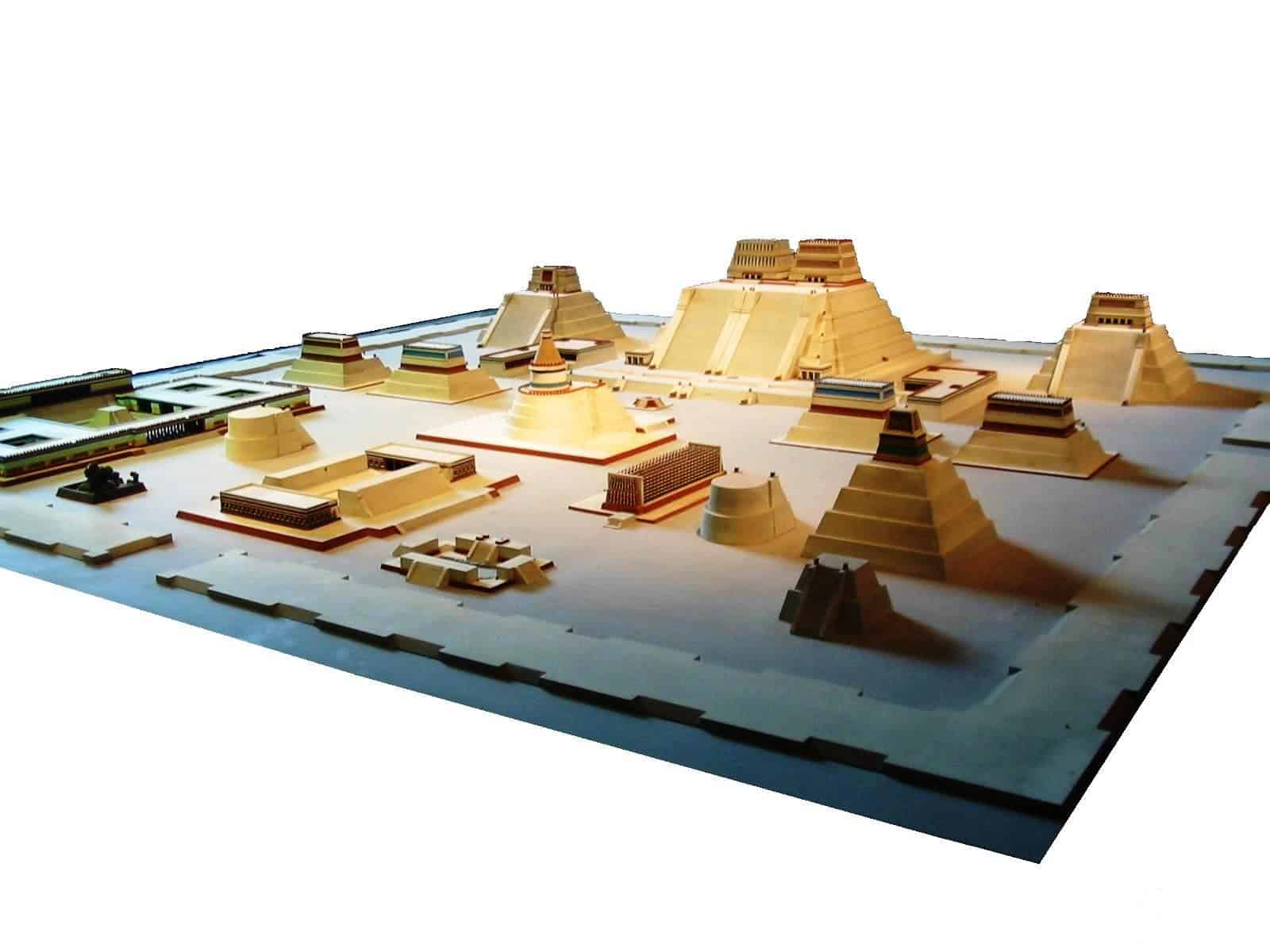
A model of Tenochtitlan based on archaeological ruins& historical text – By Thelmadatter – Own work, Public Domain, Link
In the early sixteenth century, the Aztec Empire and its capital Tenochtitlán were prospering greatly. But the Aztec Empire was a highly unstable one. It was built by bullying many smaller city-states to surrender.
So, whenever an old Aztec emperor died and a new emperor came to power, these city-states rebelled. Therefore, the first task of any Aztec emperor was to quell the rebellion and consolidate power in the regions conquered by his predecessors. Moctezuma II was also doing the same in 1519 when the Spanish invader Hernán Cortés landed on the American continent.
Hernán Cortés and Tenochtitlán
Soon after landing, Cortés learned of the Aztec Empire’s instability. So, he started allying with the rebel states to take down the Aztec Empire. As a result, Cortés, who came with just 630 men, soon had an army of several thousand men. Leading these men, he entered the Aztec capital Tenochtitlán.
But the Aztec Emperor Montezuma II did not fight them. Instead, he welcomed Cortés as a guest and let him and other Spanish invaders stay in the royal palace. But Cortes and his men soon took Moctezuma II hostage and started ruling the empire through him. After several months of their rule, Aztecs realized what was going on and killed their king, considering him a traitor. They also wanted to kill Cortés and the other Spanish invaders. But Cortés and some of his men managed to escape the city.
After Cortés escaped from Tenochtitlán, Smallpox, the disease which the Spanish had brought with them, started spreading through the Aztec city. Since the Europeans had already been hit by the disease centuries ago, they had developed resistance to it. But the Aztecs had no resistance to it. So, almost 50% of the population of Tenochtitlán died, including the newly elected Aztec emperor.
Meanwhile, Cortés gathered more allies from small city-states. Soon, he was able to gather an army of almost 100,000 men and attack Tenochtitlán.
Even though Tenochtitlán was the Aztec city that was home to the ferocious Mexica, it couldn’t hold out against Cortés’ huge army for long. Smallpox was also destroying it from the inside. So, in 1521, Tenochtitlán fell, and with it, the Aztec Empire. In the place of Tenochtitlán, a new city would be raised and come to be known as Mexico City.
Do the Aztecs still exist?
After the fall of Tenochtitlan, the fate of the Aztec people turned upside down. The Spanish started exploiting and enslaving them. The Europeans who came after them did the same as well. The diseases they brought with them took the lives of millions of Aztec people. Moreover, the Europeans, who didn’t approve of the concept of human sacrifice practiced by the Aztecs, also tried to eradicate their religion by spreading Christianity. As a result, the Aztec population decreased exponentially.
But, luckily, the Aztecs were not completely wiped out. Some of them managed to survive despite the odds stacked against them.
Today, their descendants live in small communities distributed across the rural areas of Mexico. They are referred to as Nahua. Most of these 1.5 million Nahua make their living by farming and selling handcrafted items to tourists. Many of them still follow some of the rituals practiced by their ancestors.
